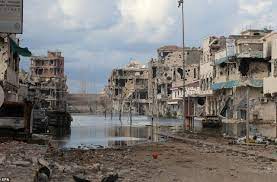- April 6, 2022
- Posted by: humanitarianweb
- Category: Humanitarian News

Civilians continued to suffer disproportionately from the impacts of explosive weapons in 2021.
This is AOAV’s eleventh annual report on harm from explosive weapons looking at global impact of explosive violence in 2021.
In 2021, AOAV recorded 19,473 deaths and injuries as a result of the use of explosive weapons around the world. Civilians continued to suffer disproportionately, accounting for 59% of total casualties, with 11,102 civilian deaths and injuries.
Of those reported harmed by explosive weapons in populated areas in 2021, 89% were civilians. In addition, civilian casualties in populated areas accounted for 93% of total civilian casualties.
Such findings reflect the consistent pattern of harm AOAV has monitored over the decade. Between 2011 and 2020, AOAV found that when explosive weapons were used in populated areas, on average nine in every ten deaths and injuries caused were civilians.
2021 marks the first year since 2015 that AOAV has recorded a rise in civilian casualties from explosive weapon use. It was also the year with the highest percentage of child casualties recorded since 2011, at 13% of the total civilian casualties – nearly double the decade average of 7%.
For the second consecutive year, Afghanistan was the worst-impacted country in terms of civilian casualties of explosive weapons, and Syria the second worst-impacted.
While this data highlights the immediate impact of explosive weapons on the lives of civilians, the reverberating consequences of explosive weapons, such as the destruction of infrastructure, displacement and the psychological harm, see millions more suffer.
The full report is available for download here: Explosive violence monitor 2021.
KEY FINDINGS
The key findings of the report are:
- In total, AOAV recorded 19,473 deaths and injuries by explosive weapons in 2,489 incidents in 2021, as reported by English language media. Of these, 11,102 were civilians – 57%.
- In total, 9,147 people were killed (of which 3,376 were civilians), and 10,326 were injured (of which 7,726 were civilians).
- When explosive weapons were used in populated areas, 89% of those killed and injured were civilians. This compares to 10% in other areas. AOAV recorded 10,295 civilians killed and injured in populated areas. This represented 93% of globally reported civilian deaths and injuries.
- The civilian harm per incident rose markedly in 2021 compared to the year before, impacting women and children more acutely:
- The number of reported child casualties rose by 11% (1,264 in 2020 to 1,407 in 2021). Last year saw the highest percentage of child casualties recorded since 2011, at 13% of the total civilian casualties. This is nearly double the average seen across the last eleven years of 7%;
- Reported female civilian casualties of explosive violence rose by 7% – from 692 (2020) to 740 (2021), though often victims’ genders go unrecorded. The proportion of civilian casualties reported to be women also saw a high of 7%, compared to the average of 3% from the last eleven years;
- The average number of civilians harmed per incident rose from 3.8 in 2020 to 4.5 in 2021 – a rise of 18%.
- Afghanistan, Syria, Gaza, Yemen and Iraq saw the highest number of global civilian casualties in 2021 with 3,051, 2,016, 1,478, 867 and 600 civilian casualties respectively:
- Afghanistan and Syria saw a decrease in harm compared to 2020;
- Gaza saw an increase from nine civilian casualties in 2020, to 1,478 in 2021 – a 16,322% rise;
- Yemen saw an increase from 683 in 2020, to 867 in 2021 – a 27% rise;
- Iraq saw an increase from 232 in 2020, to 600 in 2021 – a 159% rise;
- Ethiopia saw an increase from 34 in 2020, to 311 in 2021 – a 815% rise.
- Overall, civilian deaths and injuries from explosive violence saw an increase of less than 1% last year, compared to 2020 – the first increase in civilian casualties from explosive weapons globally since 2015.
- Manufactured explosive weapons accounted for 57% of civilian casualties (6,356); improvised explosive devices (IEDs) accounted for 43% of civilian casualties (4,726): this is the lowest number of civilians harmed by IEDs since our monitor began in 2010.
- Ground-launched manufactured explosive weapons were responsible for 31% of all civilian casualties; air-launched explosive weapons were responsible for 20% (2,231 civilians).
- Concerningly, last year the average number of civilians harmed per air-strike rose from 3.6 to 5.1, a 42% rise – fuelled by air attacks in Gaza and Ethiopia.
- Incidents were recorded in 57 countries and territories around the world; nine more locations than in 2020.
Iain Overton, Executive Director of Action on Armed Violence (AOAV), said of the report: “AOAV’s data continues to show the disproportionate impact explosive violence has on civilians, particularly when used in populated areas. The data has consistently shown that when explosive weapons are used in populated areas the vast majority of casualties will be civilian – nine in every ten casualties.
States must sign up to the political declaration that is currently being developed that will ensure civilians are protected from the use of explosive weapons in these areas.”
